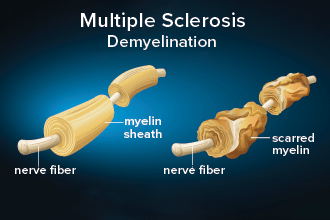Neuromyelitis optica: Symptoms, causes, diagnosis and treatment

What is neuromyelitis optica (Devic's disease)?
Neuromyelitis optica (NMO), previously known as Devic’s disease, is a rare condition in which the immune system attacks the optic nerves and spinal cord (and sometimes the brain). Symptoms of this chronic disorder may include vision loss and eye pain, along with limb weakness, numbness and paralysis.
This is not an inherited condition. However, some individuals may have another autoimmune disorder along with neuromyelitis optica. They may also have a history of family members with autoimmune disorders.
What causes neuromyelitis optica?
Neuromyelitis optica is an autoimmune disease. This means the immune system reacts against healthy tissue and begins to attack it. In neuromyelitis optica, the myelin surrounding the nerves in the central nervous system is attacked.
Myelin is a layer of protein and fat that surrounds and insulates the nerves in the body. It is critical for the quick relay of electrical impulses along nerve cells. Demyelination is the loss of myelin. When demyelination occurs, electrical impulses slow down. They can no longer transmit signals quickly.
In people with neuromyelitis optica, the body’s immune system has misidentified a specific channel in the central nervous system called aquaporin-4 (AQP4) as foreign. As a result, the body launches an inflammatory response. This autoimmune attack causes demyelination of the optic nerves and spinal cord. The result can be blindness and paralysis.
Doctors diagnose neuromyelitis optica by testing for the presence of AQP4-targeting antibodies. These are known as “anti-AQP4 antibodies.” More than 70% of people with NMO test positive for this marker.
What are the symptoms of neuromyelitis optica?
Inflammation and demyelination from NMO can cause a number of severe symptoms and complications, including:
Vision loss and impairment — usually sudden and in both eyes
Weakness, spasms, numbness or paralysis of legs and arms
Bowel or bladder issues
Vomiting and hiccups that cannot be controlled
Faded appearance of colors
Cold and heat sensitivity
Fatigue
Depression
Optic neuritis
The optic nerve can become inflamed during a flare-up of neuromyelitis optica — a condition called optic neuritis. People having an episode of optic neuritis will often feel pain inside the eye. This is followed by decreased visual acuity, or blurry vision, in one or both eyes.
Transverse myelitis
The spinal cord can also become inflamed and swollen in someone with neuromyelitis optica. This condition is called transverse myelitis. Symptoms may include:
Weakness
Sharp, shooting pain in the arms or legs
Burning or numbness in the arms or legs
Muscle spasms
Complete paralysis
When a person who is experiencing optic neuritis or transverse myelitis tests positive for anti-AQP4 antibodies, they are diagnosed with neuromyelitis optica spectrum disorder (NMOSD).
Are there different types of NMO?
The duration and frequency of NMO attacks can vary. Due to this, it can be categorized into two types:
Monophasic form
Some people may have an attack of optic neuritis or transverse myelitis once, then recover and not have any additional relapses. This is the monophasic form of neuromyelitis optica.
Relapsing form
Individuals with a severe form of NMO can have periodic relapses after the first attack. Often, the attacks are unpredictable and have no clear trigger. This is the relapsing form of neuromyelitis optica. People with the relapsing form of NMO have attacks that can occur months or years apart. Periods of partial recovery between attacks are typical.
How is NMO different from multiple sclerosis?
Demyelination that occurs in both neuromyelitis optica and multiple sclerosis (MS) is due to inflammation. As a result, optic neuritis and transverse myelitis are often seen in both diseases.

In fact, neuromyelitis optica was thought to be a subtype of multiple sclerosis in the past. However, symptoms are more severe and sudden in those with neuromyelitis optica. Also, the brain is not usually affected with NMO as it is in multiple sclerosis.
Additionally, vision issues caused by MS typically only affect one eye. In NMO, both eyes may be affected at the same time. People with multiple sclerosis also do not have the anti-AQP4 antibody marker.
Each time an NMO attack occurs, additional injury to the optic nerve and spinal cord can occur. Over time, this damage results in increased vision loss and disability. Thus, making a diagnosis early and using medications to prevent attacks is very important in management of neuromyelitis optica.
What are the similarities between neuromyelitis optica and multiple sclerosis?
Both are characterized by an abnormal immune system response.
The demyelination that occurs in both conditions is due to inflammation.
Both affect the central nervous system.
Both are more common in women.
What are the differences between neuromyelitis optica an multiple sclerosis?
NMO usually affects the spinal cord and optic nerves, while MS affects the brain as well.
Many patients with neuromyelitis optica test positive for anti-AQP4 antibodies.
Neuromyelitis optica is rare, affecting only about 4,000 people in the United States. It’s estimated that nearly 1 million people in the US have multiple sclerosis. [Read more about other rare eye diseases.]
Neuromyelitis optica has a median age of onset between 32 and 40 years of age. Multiple sclerosis has a typical age of onset between 20 and 30 years.
How is neuromyelitis optica diagnosed?
If an individual experiences an attack of optic neuritis or transverse myelitis, a doctor may order the following tests:
Blood and spinal fluid to check for anti-AQP4 antibodies and other biomarkers
MRI scan of the brain and spinal cord
Evaluation of optic nerve function
How do you treat neuromyelitis optica spectrum disorder?
The symptoms caused by neuromyelitis optica affect several parts of the body. Due to this, management of the condition must address a number of body systems.
There is no single, optimal treatment strategy or duration for NMO. Doctors need to customize a treatment plan for each individual patient. Treatment and symptom management options for neuromyelitis optica may include:
Corticosteroid drugs to reduce the effects of inflammation, particularly when a person has an attack of NMO
Plasmapheresis, a process that removes antibodies from the blood
Soliris (eculizumab), Uplinza (inebilizumab-cdon) or Enspryng (satralizumab-mwge) for individuals who test positive for AQP4 antibodies
Rituximab, a drug that reduces the B-cells in the immune system
Other drugs that suppress the immune system such as azathioprine, mycophenolate or methotrexate
Medications or electrical stimulators for pain relief
Management of decreased visual acuity
Therapy and other management strategies for paralysis
Management of bowel and bladder symptoms
Physical and occupational therapy
Social services
Is there a cure for neuromyelitis optica?
Unfortunately, there is currently no cure for neuromyelitis optica. NMO is managed by treating symptoms and using medications to prevent relapses. Neuromyelitis optica can cause worsening disability with each relapse, including:
Decreased vision
Weakness or paralysis of the legs and arms
With time, individuals may need the assistance of a ventilator to breathe.
A team of specialists such as neurologists, ophthalmologists and optometrists who specialize in low vision can help you manage your neuromyelitis optica. Support from family, friends and additional health care providers is essential. Groups such as the Sumaira Foundation for NMO can be critical in finding support for individuals with this condition.
READ NEXT: Is eye twitching a sign of MS?
Neuromyelitis optica spectrum disorder. NORD (National Organization for Rare Disorders). Accessed February 2022.
Neuromyelitis optica. National Health Service. December 2020.
Neuromyelitis optica. National Multiple Sclerosis Society. November 2019.
Myelin. MedlinePlus Medical Encyclopedia. Accessed February 2022.
Neuromyelitis optica (Devic's syndrome). Handbook of Clinical Neurology. 2014.
Neuromyelitis optica. Johns Hopkins Medicine. Accessed February 2022.
Devic's Disease. UCSF Benioff Children's Hospitals. Accessed February 2022.
Demyelinating diseases. Journal of Clinical Pathology. November 2006.
Imaging of noninfectious inflammatory disorders of the spinal cord. Handbook of Clinical Neurology. 2016.
Understanding MS. National Multiple Sclerosis Society. Accessed March 2022.
Page published on Thursday, April 7, 2022






